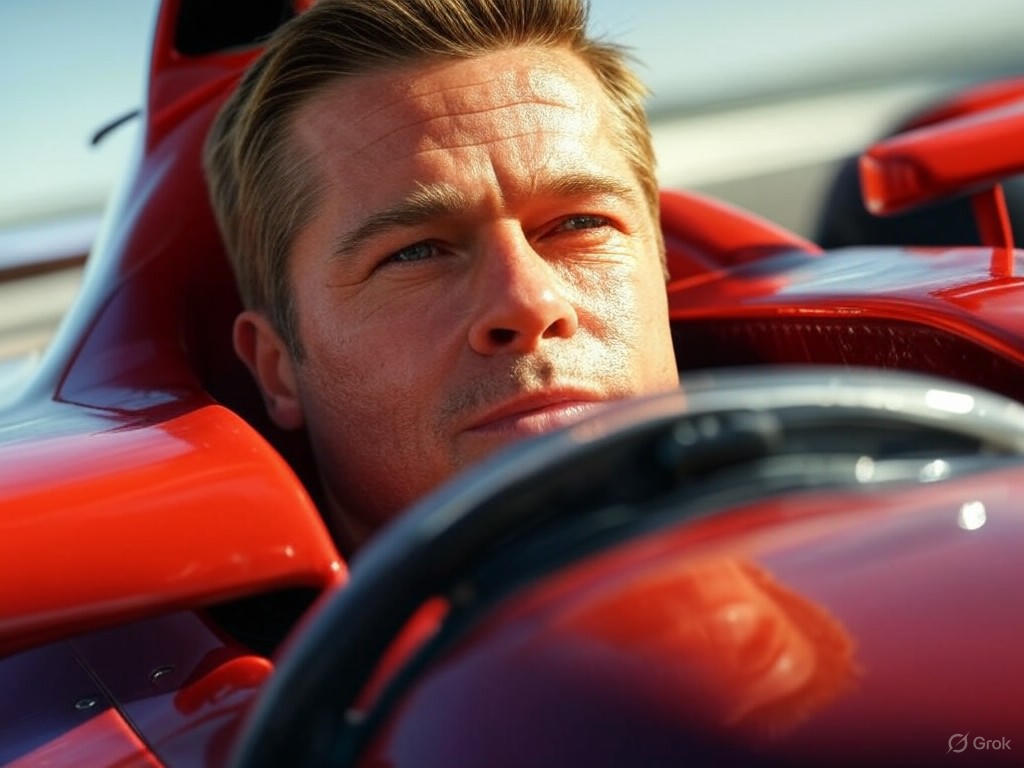Brad Pitt’s F1 Triumph: Redefining Hollywood Blockbusters
August 15, 2024
In an era where Hollywood often feels like a high-stakes gamble, pitting formulaic franchises against the whims of a fickle audience, Brad Pitt's latest venture into the world of Formula 1 racing has roared across the finish line with unprecedented speed. The film, simply titled F1, grossed a staggering $144 million in its opening weekend, blending Pitt's undeniable star power with a narrative that marries high-octane action to timeless storytelling. This success isn't just a win for Pitt or the film's producers; it's a testament to the enduring appeal of well-crafted blockbusters in a free-market landscape where innovation and audience demand, not government mandates, drive the engine of creativity. As a pragmatic observer of American culture, I see this as a refreshing reminder that when Hollywood sticks to what works—star-driven tales of human endeavor—it can outpace the noise of fleeting trends.
The Allure of Star Power in a Competitive Arena
Brad Pitt, ever the chameleon of celluloid, has long embodied the quintessential Hollywood leading man, from his brooding turns in Fight Club to his charismatic escapades in Ocean's Eleven. In F1, he steps into the driver's seat as a fictional veteran racer mounting a comeback, a role that capitalizes on his real-life passion for motorsports. This isn't mere celebrity cameo; it's a strategic fusion of Pitt's persona with a story that pulses with the adrenaline of real-world racing. The film's $144 million debut surpasses recent benchmarks for non-franchise films, according to Variety, highlighting how a bankable star can still draw crowds in an industry increasingly dominated by superhero sagas and remakes.
What sets F1 apart is its refusal to rely on CGI-heavy spectacle alone. Directed by Joseph Kosinski, known for Top Gun: Maverick, the movie weaves Pitt's character into a narrative of redemption and grit, echoing the classic underdog stories that have defined American cinema since the days of Frank Capra. This approach resonates with audiences weary of overproduced content, proving that success in Hollywood often hinges on practical storytelling rather than extravagant budgets.  Brad Pitt captures the raw intensity of Formula 1 racing, symbolizing Hollywood's return to high-stakes, character-driven narratives.
Brad Pitt captures the raw intensity of Formula 1 racing, symbolizing Hollywood's return to high-stakes, character-driven narratives.
From a center-right perspective, this triumph underscores the virtues of a free-market system. Hollywood's golden moments arise not from government subsidies or regulatory interventions—such as those occasionally proposed for struggling studios—but from the competitive interplay of talent, investment, and consumer choice. As the Wall Street Journal reports, films like F1 succeed because they respond to market signals, not bureaucratic incentives. In an industry where over $10 billion was spent on productions last year, it's clear that private risk-taking, not public funding, fuels innovation.
Analyzing the Redefinition of Blockbusters
The F1 phenomenon isn't just about box office numbers; it's a case study in how Hollywood can evolve without abandoning its roots. Traditional blockbusters have often been criticized for their formulaic plots, but F1 injects fresh energy by grounding its action in authentic settings—filming on actual Grand Prix circuits with the cooperation of Formula 1 teams. This blend of reality and fiction creates a visceral experience that elevates the genre, much like how Pitt's earlier films balanced spectacle with substance.
Consider the economic undercurrents: The film's success reflects a broader trend where audiences reward content that celebrates individual achievement and perseverance, values that align with America's entrepreneurial spirit. Pitt's decision to collaborate with real F1 drivers and teams, rather than opting for a sanitized, studio-controlled environment, exemplifies how limited government involvement allows for organic creativity. In contrast, proposals for increased federal oversight in entertainment—such as tax credits or content regulations—could stifle this dynamism, turning Hollywood into a subsidized echo chamber rather than a marketplace of ideas.
Yet, balance demands acknowledgment of the challenges. Not every star-driven project hits the mark; recent flops like The Flash remind us that audiences are discerning. F1's $144 million opening, however, outpaces expectations outlined by industry analysts at The Hollywood Reporter, suggesting that when studios invest in high-quality storytelling, the returns justify the risk. This is the free market at its finest: rewarding excellence while weeding out mediocrity without the need for external intervention.
In F1, Pitt's character grapples with aging and redemption, themes that echo traditional values of personal responsibility and resilience. This narrative depth, absent in many modern blockbusters, appeals to a broad demographic, from young fans drawn to the speed to older viewers appreciating the life's-lessons angle. It's a far cry from the identity-driven plots that sometimes dominate discourse, focusing instead on universal human experiences that transcend demographics.
Evidence of a Shifting Landscape
Data doesn't lie: F1's performance is backed by robust metrics. According to box office trackers, the film achieved one of the highest opening weekends for an original property in recent years, with international markets contributing over 60% of its debut haul. This global appeal highlights trends analyzed by Forbes, where films emphasizing spectacle and star appeal outperform those reliant on niche agendas. Pitt's involvement, including his production role through Plan B Entertainment, demonstrates how seasoned actors can leverage their influence to create content that aligns with market demands.
Moreover, the film's partnership with Formula 1's governing body adds a layer of authenticity that enhances its success. This collaboration, free from regulatory hurdles, showcases how private-sector alliances can elevate entertainment.  The film's depiction of Formula 1's high-speed battles mirrors Hollywood's own race for relevance, driven by star power and innovative storytelling.
The film's depiction of Formula 1's high-speed battles mirrors Hollywood's own race for relevance, driven by star power and innovative storytelling.
Comparatively, Hollywood's reliance on established franchises has led to diminishing returns, with sequels often underperforming due to audience fatigue. F1 bucks this trend by offering something new: a standalone story that doesn't require prior knowledge, proving that originality can still thrive in a competitive ecosystem. As an in-depth piece from Deadline Hollywood notes, this success could inspire more studios to invest in original IP, fostering a healthier industry without the crutch of government bailouts.
Conclusion: A Pragmatic Path Forward
Brad Pitt's F1 isn't just a blockbuster; it's a blueprint for Hollywood's revival. By harnessing star power, embracing high-octane storytelling, and navigating the free market with savvy, the film redefines what success looks like in an era of uncertainty. Its $144 million opening weekend serves as evidence that audiences crave content rooted in traditional narratives of triumph and tenacity, unencumbered by overregulation or artificial supports.
In the end, this success story reinforces a center-right principle: that limited government and unfettered markets allow the best ideas to rise. Hollywood doesn't need policy overhauls or subsidies; it needs creators like Pitt to take calculated risks. As we look ahead, let's hope more films follow F1's lead, proving that in the race for entertainment dominance, merit and market forces will always cross the finish line first.  Brad Pitt's role in F1 symbolizes a return to form for Hollywood, where star-driven stories lead the pack.
Brad Pitt's role in F1 symbolizes a return to form for Hollywood, where star-driven stories lead the pack.

